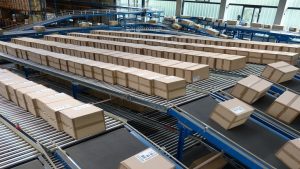
The study found chief supply chain officers expect the labour shortage to continue to grow in their industry. 64% have noticed generational differences in employment preferences that will have a long-term impact on labour availability. Along with many warehouse labourers permanently leaving the field due to a multitude of factors including reskilling, pandemic-related illness and an aging workforce. The industry is also being hit with a combination of population forces. The lowest birth rate in US history paired with Baby Boomers retiring out of the workforce. As well as a generational shift in what employees are looking for in their careers and workplaces.

“Labour issues across industries continue to vacillate. However, unlike the temporary shortages seen in other industries, continued eCommerce growth and shifts in generational employment preferences are uniquely impacting the fulfilment industry. It is predicted to lead to long-term labour shortages that will only compound in the coming years,” said Steve Johnson, President and COO at Berkshire Grey.
“In addition to compensation strategies, companies need to utilise robotics automation in order to stay ahead of this demographic shift. Not only is it a huge attractor for young talent due to the increased safety and specialised upskilling it enables. It is also a game changer in terms of cost reduction, throughput and ROI.”
Robotics Automation improves talent attraction and retention
With more than half (57%) of executives believing labour shortages have hindered their ability to meet demand. The research suggests it is critical for supply chain decision-makers to find a way to bridge the gap. 76% of executives believe they’ll need to raise wages. 63% believe they’ll need to increase bonuses to attract and retain workers. Executives also believe robotics automation is a promising talent attractor.
- 71% of executives believe robotics automation is necessary to counter reduced applications from younger generations.
- 13% of executives are currently using robotic automation, they are keenly aware this is where the industry is headed. This is evidenced by 51% of executives being in the process of adopting or planning to adopt robotics.
- 51% of executives believe implementing automation will increase employee satisfaction. 43% believe it will lead to a decrease in employee turnover.
Consumer demands and expectations are rising
Rising consumer expectations and on-demand shopping resulting from the COVID-19 pandemic are requiring retail and eCommerce companies to greatly step up their throughput. Analysts predict the eCommerce market to increase from $3.3 trillion to $5.3 trillion by 2026.
- Free returns are growing to be table stakes. 72% of executives believe they would lose customers if they didn’t offer free returns.
- 68% of executives believe they will need same day or faster delivery speeds within two years.
- 80% of executives that saw an increase in return rates in 2020 have needed to increase headcount to accommodate the increase of returns.
Automation’s impact on the bottom line
Since 2019, the percentage of executives who believe automation is mainstream has increased by nearly 43%. This rise in awareness and adoption is no surprise given the huge cost savings and throughput increases robotics automation is providing amidst supply chain challenges.
- 78% of executives expect to save more than 10% on order fulfilment costs as a result of robotics automation.
- Most executives (85%) currently using robotics are planning to increase their investment.
- Executives are most likely to use automation to support packaging/labeling (62%), item sortation (59%), returns (58%) and goods retrieval (58%).
The results contained within the report are based on a survey of over 200 senior-level supply chain decision-makers in the US at eCommerce and retail businesses.
Enterprise Times: What this means for business
The unprecedented growth in eCommerce sales is overwhelming fulfilment operations are generally labour intensive and constrained by manual operations. Throw in the growing labour shortages industries are facing across the globe. So, its not surprising that nearly three-quarters of executives see robotics automation in warehouses as a solution for the growing gap in younger job applicants. Over half (51%) of executives confirmed they were in the process of adopting or planning to adopt robotics. 78% expect order fulfilment cost savings of more than 10%.
Fulfilment is often considered the last mile of the eCommerce process. It’s pretty essential. After all your investment in designing and enhancing the digital user experience and making your digital collateral as engaging as possible. A smooth and streamline checkout process, with a variety of shipping options enabled by your chosen payment method. If, after all of this, the customer fails to receive their goods and services on time. Or, in the good condition expected by consumers, then the enterprise may as well as shut up shop. The world of fulfilment has experienced a number of fundamental challenges in recent years. Embracing technology, in particular automation, perhaps is the only salvation for this essential sector.


























